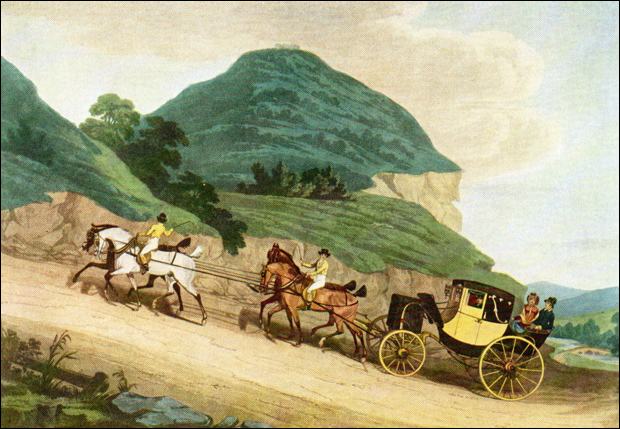
Some articles and blogs claim that all chaises and post chaises must be yellow. However, the only requirement I’ve found or a particular color of any carriage is one from the Four Horse Club, that a member’s barouche must be yellow. So… Why always yellow for the chaise?
The cracking of the whips, the thundering of hooves…the dashing yellow bounder rattling along the roads must’ve been a breathtaking sight.
Yellow bounders were the name for post-chaises because they were commonly painted yellow. Typically these were paid conveyances (rather than owned), although the color was also popular among clubs and other sporting chaps for vehicles like high perch phaetons and curricles.
Based on my research, I believe there are two main reasons why yellow was the uniform color: cost and visibility. I have included some relevant snippets below that illustrate my reasoning. The cost issue was likely the main consideration. This tome on carriages (A Treatise on Carriages: Comprehending Coaches, Chariots, Phaetons) suggests a person can greatly reduce initial cost and maintenance if the color of the body is good enough to simply varnish over. Varnish used on coaches, when layered, gave off a yellow hue: “saw the painter varnish it which is pretty to see how every doing it over do make it more and more yellow” (, 1912).

Comprising the horse and carriage keeper’s oracle, 1827
English Pleasure Carriages: Their Origin, History, Varieties…, 1837)
(A Treatise on Carriages: Comprehending Coaches, Chariots, Phaetons…, 1792).
The visibility factor, in many respects, relates the tradition that still has many taxis in America painted yellow. In the early 1900s, one entrepreneur would pay to understand that yellow is the most visible color to the eye when moving at speeds…something I would argue the Georgians already knew (http://www.slate.com/blogs/the_eye/2013/10/25/taxis_who_decided_they_should_be_yellow.html). For fast moving sporting or mail coaches, it made sense that you could see them “bounding” down the road, so that pony carts, gigs or other slow moving conveyances could get out of the way.

Started in 1808, the Four Horse Club meet twice a month in Cavendish Square and was also known as the Barouche Club and the Whip Club (Baily’s Magazine of Sports & Pastimes, Vol. 54, p. 43, 1890). Here is a snippet from The Carriage Journal (1970) about them: “The Four Horse Club ruled that the bodies of these carriages should be painted yellow, and the horses drawing them should be bays, though it is recorded that one member, Mr. Annesley, always drove roans.”
I suspect, as mentioned above, the reason for the yellow was very much cost and visibility. According to one resource (Carriages and Coaches…, 1912) cabriolets in the 1820s were also commonly painted yellow, suggesting that it may also have been a fashionable color for vehicles. I have also seen it spoken in terms of “sporting colors” suggesting that yellow was like a flashy, sporty color to have (much in the way red sports cars have been in modern era). It make sense that sporting vehicles (that frequently crashed) would require affordable maintenance and high visibility (to avoid said crashes).
Another interesting tidbit about the color yellow. In my research, I came across this very interesting history of the “yellow car game” which I think American’s have morphed into a game affectionately called “Slug bug”. Apparently early carts full of rapeseed would take on the yellow tint, and locals formed a habit of punching each others arms to wish a safe journey or luck. There is more at the link, but reveals some of the long history of yellow vehicles.
I found this topic infinitely fascinating, and so did a lot more research than is condensed above to arrive at my conclusions. However, I am always interested to hear what other historians have come across in their readings…so feel free to give me a shout!









